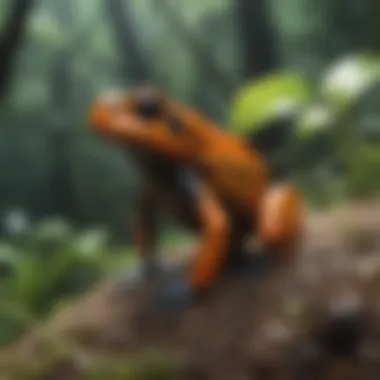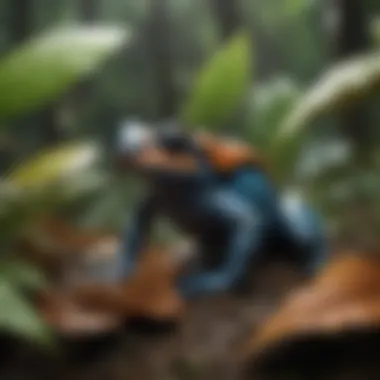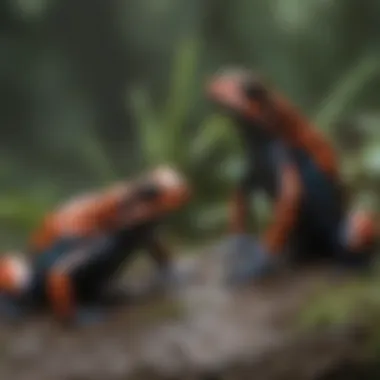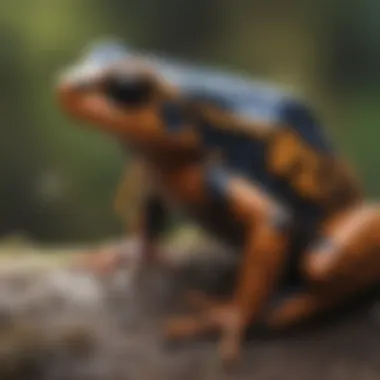Discover the Enchanting Secrets of Poison Frogs: A Fascinating Exploration


Nature Topic Overview
Unveil the captivating realm of poison frogs, basked in hues as vibrant as they are deadly. These diminutive creatures possess a charm that belies their lethal nature. From their unique physical attributes to their intricate habitats and intriguing behaviors, poison frogs stand as a testament to the wonders of the natural world. Dive into this narrative as we unravel the enthralling facts that define these tiny yet potent amphibians.
Fun Facts and Trivia
- Poison frogs come in a kaleidoscope of colors, showcasing a visual feast for the eyes, captivating not only for humans but signaling danger to potential predators through aposematic signals. Despite their tiny size, these amphibians possess enough toxic secretions to deter even the most formidable of foes, heightening their aura of mystique and danger. Their mating rituals are as intricate and colorful as their appearances, with males exhibiting elaborate dances to woo their partners in a spectacle of nature's diversity.
Wildlife Explorations
Delve into the realm of diverse poison frog species, each a marvel of adaptation and evolution. From the iconic Golden Poison Frog to the striking Strawberry Poison Dart Frog, each species boasts unique traits and habitats that showcase nature's boundless creativity. Explore the lush rainforests and tropical regions where these amphibians thrive, coexisting with a plethora of flora and fauna in delicate ecological balances. Interactive elements such as quizzes and puzzles offer insights into the behaviors and adaptations that allow poison frogs to survive and thrive in their complex environments.
Environmental Awareness
The conservation of poison frogs is crucial for maintaining the delicate ecosystems they inhabit. By preserving their habitats and raising awareness about the threats they face, we can contribute to the sustainability of these unique creatures. Educating children on the importance of biodiversity and conservation empowers them to become stewards of the environment, instilling a sense of responsibility towards protecting nature's wonders. Tips on sustainable practices and how youngsters can actively participate in safeguarding wildlife further underscore the significance of environmental consciousness.
DIY Nature Activities
Engage young nature enthusiasts with hands-on activities inspired by the vibrant world of poison frogs. From creating frog-themed crafts using eco-friendly materials to embarking on outdoor explorations to observe local wildlife, children can immerse themselves in the wonders of nature. Step-by-step guides offer instructions for crafting frog habitats or conducting science experiments that deepen understanding of ecosystems and animal behavior. Encouraging kids to channel their curiosity into creative ventures fosters a lifelong appreciation for the natural world and ignites a passion for conservation efforts.
Introduction to Poison Frogs
In this section, we embark on a fascinating journey into the realm of poison frogs. These tiny creatures, known for their vibrant colors and deadly toxins, captivate the imagination through their unique characteristics and behaviors. Exploring the evolutionary marvel of poison frogs offers a glimpse into a world where beauty meets danger.
Evolutionary History
Origins of Poison Frog Species
The origins of poison frog species unveil a groundbreaking narrative of adaptation and survival. These remarkable amphibians have evolved specialized traits to develop potent toxins, effectively warding off potential predators. The intricate interplay of genetic mutations and environmental pressures has sculpted the diverse array of poison frog species we observe today. By delving into their origins, we unravel the profound genetic legacy that distinguishes these frogs as nature's marvels.
Genetic Adaptations for Toxicity
The genetic adaptations for toxicity in poison frogs epitomize nature's intricate design. Through generations of selective breeding, these frogs have honed their ability to synthesize potent alkaloids, serving as a powerful defense mechanism. This genetic arsenal not only safeguards the frogs from harm but also serves as a testament to the complexities of evolutionary biology. Understanding the genetic adaptations for toxicity provides a glimpse into the remarkable resilience these creatures embody.
Physical Features
Bright Colors and Patterns


The bright colors and intricate patterns adorning poison frogs are not merely aesthetic traits but serve as visual warnings to potential predators. These vibrant hues signal danger, cautioning those in their midst of the toxic defenses lurking within. The evolution of such striking colorations showcases nature's remarkable adaptation strategies, where beauty aligns with self-preservation in a mesmerizing display of survival tactics.
Distinctive Skin Texture
The distinctive skin texture of poison frogs is a marvel of biology, offering insights into their adaptation to diverse habitats. From smooth to bumpy surfaces, each texture serves a specific purpose in enhancing camouflage or deterring predators. The intricate patterns and textures of their skin not only add to their visual appeal but also play a crucial role in their survival within dynamic ecosystems. Exploring the nuances of their skin textures paints a vivid picture of the evolutionary arms race these frogs engage in.
Habitats and Distribution
The topic of habitats and distribution is crucial in understanding the complex ecosystem of poison frogs. These petite creatures are highly dependent on their surroundings for survival and reproduction. By exploring their habitats, we gain insight into the diverse environments they inhabit and how these environments shape their behavior and physical traits. Understanding the distribution of poison frogs across different regions also provides valuable information on their adaptability and range.
Tropical Rainforests
Amazon Rainforest
The Amazon Rainforest stands out as a prominent habitat for a variety of poison frog species. Its lush vegetation and diverse microhabitats create ideal conditions for these amphibians to thrive. The high humidity and abundance of both aquatic and terrestrial resources in the Amazon Rainforest support the unique dietary and reproductive needs of poison frogs. Despite the intense competition for resources and the presence of predators, poison frogs have evolved intricate behaviors and adaptations to survive in this challenging yet rewarding ecosystem.
Diverse Ecosystems
Poison frogs can also be found in diverse ecosystems beyond the Amazon Rainforest. These ecosystems offer a range of microclimates and habitats that cater to different species of poison frogs. From montane forests to swamps, each ecosystem provides unique challenges and opportunities for these amphibians. The ability of poison frogs to adapt to various environmental conditions showcases their resilience and evolutionary versatility. By existing in diverse ecosystems, poison frogs contribute to the overall biodiversity and ecological balance of their respective habitats.
Global Range
Central and South America
Central and South America harbor a significant number of poison frog species, each adapted to its specific microhabitat within the region. The warmth and humidity of these tropical regions create optimal living conditions for poison frogs, allowing them to display a stunning array of colors and patterns. The interconnectedness of Central and South American ecosystems further promotes species diversity and genetic variation among poison frogs. Despite the ongoing threat of habitat destruction and climate change, these regions remain critical for the conservation of poison frog populations.
Afrotropical Regions
In the Afrotropical regions, poison frogs exhibit unique characteristics distinct from their counterparts in the Americas. The diverse landscapes and climatic conditions of Afrotropical regions offer a different set of challenges and opportunities for poison frogs to thrive. While the competition may vary, poison frogs in these regions have developed specific adaptations to predators and environmental stressors. Studying poison frogs in Afrotropical regions not only expands our knowledge of their global distribution but also highlights the importance of protecting these lesser-known populations to ensure the long-term survival of these fascinating amphibians.
Toxicity and Defense Mechanisms
In this section of the article, we delve deep into the crucial aspects of the toxicity and defense mechanisms exhibited by poison frogs. The significance of understanding these mechanisms lies in unraveling how these tiny creatures protect themselves from predators. Poison frogs have developed a remarkable ability to synthesize toxins, which act as a deterrent to potential threats. This defense mechanism is not only fascinating but also essential for the survival of these amphibians in their natural habitats.
Types of Alkaloids
Types of Alkaloids play a pivotal role in the poison frog's arsenal of chemical defenses. These compounds are synthesized within the frog's skin glands and possess varying degrees of toxicity. The key characteristic of Types of Alkaloids lies in their ability to cause adverse reactions in predators, ranging from mild discomfort to fatality. Their unique feature is how they target the nervous system of predators, sending a warning signal of danger associated with consuming these frogs. While the advantages include protection from predation, the disadvantages may involve inadvertent harm to non-threatening species in the environment.
Toxicity Levels


The Toxicity Levels present in poison frogs contribute significantly to their deterrent effect on predators. These levels determine the potency of the toxins produced by the frogs, influencing how effective they are in warding off threats. High Toxicity Levels ensure that even minute contact with the frog can lead to severe consequences for predators. This heightened toxicity acts as a form of defense escalation, deterring predators from repeated attempts at predation. The advantage of such high toxicity is the ability of the frogs to ward off a wide range of predators effectively, ensuring their survival. However, the disadvantage lies in the potential danger posed to animals encountering these frogs unintentionally, emphasizing the need for caution in their natural habitat.
Warning Colors
The discussion extends to the mesmerizing warning colors exhibited by poison frogs, which serve as a visual cue to potential predators. These vibrant hues, known as aposematic coloration, indicate the toxic nature of the frogs, warning predators to steer clear. The role of aposematism in these frogs' survival strategy is paramount, as it allows for easy recognition and avoidance by predators. The unique feature of warning colors is their ability to communicate danger without the need for physical confrontation. While the advantage lies in effectively deterring predators without harm, the disadvantage may involve attracting predators that have developed immunity to the frogs' toxins through co-evolution.
Predator Avoidance
Furthermore, the section explores the intricate mechanisms of predator avoidance adopted by poison frogs. These mechanisms involve behavioral adaptations that aid in evading detection by predators. The key characteristic of predator avoidance lies in the frogs' ability to sense and respond to potential threats swiftly. This quick reflex ensures their survival in the face of looming danger. The advantage of such predator avoidance techniques is the improved chances of survival for the frogs in their predator-rich environments. However, a potential disadvantage could be the energy expenditure associated with maintaining a heightened alertness level to avoid predation.
Feeding Behavior
In this section about feeding behavior, we delve into the intricate eating habits of poison frogs, shedding light on crucial aspects of their survival. Understanding the feeding behavior of these tiny creatures is paramount to comprehend their ecological role and adaptation strategies. Their dietary preferences dictate their foraging techniques, impacting their energy acquisition and overall fitness.
Dietary Preferences
Insectivorous Diet
Exploring the insectivorous diet of poison frogs reveals their specialized feeding behavior focused on consuming a plethora of tiny insects. This dietary choice is fundamental to their survival, providing essential nutrients and energy required for physiological functions. The key characteristic of this diet lies in the consumption of various insects like ants, beetles, and termites, ensuring a well-rounded nutritional intake. The unique feature of the insectivorous diet is its high protein content, aiding in muscle development and metabolic processes. While this diet ensures a diverse nutritional profile, it also poses challenges in finding specific insect prey in their natural habitat.
Variety of Prey
The diverse range of prey species targeted by poison frogs showcases their adaptive feeding behavior and ecological flexibility. This dietary diversity enables poison frogs to maintain balance in their ecosystem by regulating insect populations. The key characteristic of this aspect is the ability of poison frogs to target different prey items based on availability and nutritional content. Having a variety of prey options ensures that poison frogs can adapt to changing environmental conditions and food availability. One unique feature of this diet is the selective targeting of specific prey species for nutritional benefits while avoiding potentially toxic insects. However, the variation in prey selection may pose challenges in obtaining essential nutrients consistently.
Foraging Techniques
Tongue Projection Mechanism
Examining the tongue projection mechanism employed by poison frogs uncovers their efficient hunting strategy for capturing elusive prey. This specialized technique allows poison frogs to rapidly extend their tongues to catch fast-moving insects with precision. The key characteristic of this mechanism is its rapid and accurate tongue movement, ensuring successful prey capture. The unique feature of the tongue projection mechanism is its adhesive properties, enabling poison frogs to grasp and secure prey effectively. While this technique enhances foraging efficiency, it necessitates quick reflexes and precise targeting to maximize hunting success.
Hunting Strategies
Analyzing the diverse hunting strategies of poison frogs unveils their adaptive behaviors in securing food resources within their habitat. The key characteristic of these strategies lies in the varied approaches employed by poison frogs, including ambush predation, active hunting, and cooperative foraging. These strategies are beneficial as they allow poison frogs to optimize energy expenditure while maximizing prey acquisition. One unique feature of these hunting strategies is their adaptability to different environmental conditions, enabling poison frogs to thrive in diverse habitats. However, the effectiveness of these strategies may vary based on factors like prey availability and competition from other predators.
Reproduction and Parental Care
Reproduction and parental care are crucial aspects of the poison frogs' life cycle that warrant exploration in this article. These tiny creatures have intricate mating rituals and unique behaviors related to caring for offspring. Understanding the reproductive behaviors of poison frogs offers insight into their evolutionary adaptations and survival strategies. Parental care among poison frogs is unusual among amphibians, making it a significant topic of discussion to highlight their species-specific behaviors and ecological roles.
Mating Rituals


Mating rituals among poison frogs constitute a fascinating aspect of their behavior. The section delves into two distinct components: territorial displays and female mate selection. These rituals play a pivotal role in mate attraction and reproductive success, shedding light on the intricate dynamics of poison frog courtship.
Territorial Displays
Territorial displays are a key element in poison frog mating rituals, serving as signals of dominance and fitness. Through these displays, male frogs establish territories and attract potential mates. The unique vocalizations and vibrant color displays during territorial interactions convey critical information about the frog's health and genetic quality, contributing to successful breeding outcomes.
Female Mate Selection
Female mate selection is a critical aspect of poison frog reproduction, where females assess male qualities before choosing a mate. Factors such as color intensity, territory size, and courtship displays influence female choice in selecting a suitable partner. Examining female mate selection provides valuable insights into the evolutionary pressures that have shaped poison frog behaviors.
Egg Deposition
Egg deposition in poison frogs is a carefully orchestrated process with distinct features worth exploring. This section focuses on two primary components: clutch size and male involvement. Understanding the intricacies of egg deposition sheds light on the parental investment and reproductive strategies of poison frogs.
Clutch Size
Clutch size plays a crucial role in the reproductive success of poison frogs, impacting offspring survival and parental investment. The discussion highlights the variations in clutch size among different poison frog species and the ecological factors influencing this reproductive trait. Analyzing clutch size offers valuable information on the species' reproductive strategies.
Male Involvement
Male involvement in egg deposition varies significantly among poison frog species, with some exhibiting active participation in caring for and protecting the eggs. This section delves into the behavioral patterns of male frogs regarding nest-building, egg guarding, and tadpole care. Exploring male involvement provides insights into the division of parental responsibilities and the survival advantages it confers.
Conservation Status
Conservation status plays a vital role in understanding and safeguarding the survival of poison frogs in their natural habitats. In this article, we delve deeply into the complexities of conservation efforts concerning these mesmerizing creatures. Exploring the conservation status of poison frogs is crucial to grasp the impact of human activities on their populations and the ecosystem they inhabit. By shedding light on conservation status, we aim to highlight the urgency of protecting these delicate amphibians.
Threats and Challenges
Habitat Loss
Habitat loss stands as one of the foremost threats to poison frogs and their biodiversity. Disturbances in their habitats, especially due to deforestation and urban development, lead to fragmentation and degradation of their living spaces. This loss of habitat not only disrupts the frogs' natural behavior and breeding patterns but also exposes them to predators and environmental stressors. Understanding the detrimental effects of habitat loss is essential in devising effective conservation strategies to mitigate its impact and ensure the long-term survival of these remarkable creatures.
Illegal Pet Trade
The illegal pet trade poses a severe threat to poison frogs, as they are often captured and traded for their vibrant colors and rarity in the exotic pet market. This illicit activity not only decimates wild populations but also disrupts the delicate ecological balance that these frogs are part of. The demand for poison frogs in the pet trade leads to unsustainable harvesting practices, further endangering already vulnerable species. Addressing the challenges posed by the illegal pet trade requires stringent enforcement of wildlife protection laws and raising awareness about the importance of preserving these enigmatic amphibians in their natural habitats.
Protection Efforts
Protected Areas
Establishing protected areas is a fundamental conservation strategy aimed at preserving the critical habitats of poison frogs and other endemic species. These designated zones provide a safe sanctuary where these frogs can thrive without facing immediate threats from human activities. Protected areas not only safeguard biodiversity but also enable scientific research and eco-tourism opportunities, promoting awareness and appreciation for these unique amphibians. By emphasizing the significance of protected areas, we underscore the importance of maintaining healthy ecosystems for the well-being of poison frogs and the broader environment.
Community Initiatives
Community initiatives play a pivotal role in engaging local populations in conservation efforts and fostering a sense of stewardship towards poison frog populations. By involving communities in habitat restoration, monitoring programs, and education campaigns, these initiatives empower individuals to become active participants in wildlife conservation. Community involvement also strengthens the social fabric and ensures sustainable practices that benefit both people and nature. Highlighting the impact of community initiatives underscores the collaborative approach needed to protect the delicate balance of ecosystems and promote coexistence with poison frogs.







